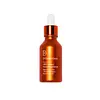What's inside
What's inside
 Key Ingredients
Key Ingredients

 Benefits
Benefits

 Concerns
Concerns

 Ingredients Side-by-side
Ingredients Side-by-side

Water
Skin ConditioningDipropylene Glycol
HumectantAscorbic Acid
AntioxidantDimethyl Isosorbide
SolventRicinoleth-40
CleansingAminomethyl Propanol
BufferingLactic Acid
BufferingTocopherol
AntioxidantGlycyrrhiza Glabra Root Extract
BleachingFerulic Acid
AntimicrobialMorus Alba Fruit Extract
AntioxidantSodium Hyaluronate
HumectantGlycolic Acid
BufferingAdenosine
Skin ConditioningGlycerin
HumectantPhenoxyethanol
PreservativeWater
Skin ConditioningSodium Ascorbyl Phosphate
AntioxidantPentylene Glycol
Skin ConditioningGlycerin
HumectantNiacinamide
SmoothingPropanediol
SolventCarrageenan
Erythritol
HumectantSodium PCA
HumectantXanthan Gum
Emulsifying1,2-Hexanediol
Skin ConditioningHydroxyacetophenone
AntioxidantAcetyl Hexapeptide-8
HumectantCaprylyl Glycol
EmollientDisodium Phosphate
BufferingSodium Phosphate
BufferingSodium Hyaluronate
HumectantAnogeissus Leiocarpus Bark Extract
Skin ProtectingSodium Phytate
Hydrangea Arborescens Root Extract
Skin ConditioningMorus Alba Root Extract
BleachingPolysorbate 20
EmulsifyingResveratrol
AntioxidantScutellaria Lateriflora Extract
Skin ConditioningPentapeptide-21
Skin ConditioningAvena Sativa Kernel Extract
AbrasiveWater, Sodium Ascorbyl Phosphate, Pentylene Glycol, Glycerin, Niacinamide, Propanediol, Carrageenan, Erythritol, Sodium PCA, Xanthan Gum, 1,2-Hexanediol, Hydroxyacetophenone, Acetyl Hexapeptide-8, Caprylyl Glycol, Disodium Phosphate, Sodium Phosphate, Sodium Hyaluronate, Anogeissus Leiocarpus Bark Extract, Sodium Phytate, Hydrangea Arborescens Root Extract, Morus Alba Root Extract, Polysorbate 20, Resveratrol, Scutellaria Lateriflora Extract, Pentapeptide-21, Avena Sativa Kernel Extract
 Reviews
Reviews

Ingredients Explained
These ingredients are found in both products.
Ingredients higher up in an ingredient list are typically present in a larger amount.
Glycerin is already naturally found in your skin. It helps moisturize and protect your skin.
A study from 2016 found glycerin to be more effective as a humectant than AHAs and hyaluronic acid.
As a humectant, it helps the skin stay hydrated by pulling moisture to your skin. The low molecular weight of glycerin allows it to pull moisture into the deeper layers of your skin.
Hydrated skin improves your skin barrier; Your skin barrier helps protect against irritants and bacteria.
Glycerin has also been found to have antimicrobial and antiviral properties. Due to these properties, glycerin is often used in wound and burn treatments.
In cosmetics, glycerin is usually derived from plants such as soybean or palm. However, it can also be sourced from animals, such as tallow or animal fat.
This ingredient is organic, colorless, odorless, and non-toxic.
Glycerin is the name for this ingredient in American English. British English uses Glycerol/Glycerine.
Learn more about GlycerinSodium Hyaluronate is hyaluronic acid's salt form. It is commonly derived from the sodium salt of hyaluronic acid.
Like hyaluronic acid, it is great at holding water and acts as a humectant. This makes it a great skin hydrating ingredient.
Sodium Hyaluronate is naturally occurring in our bodies and is mostly found in eye fluid and joints.
These are some other common types of Hyaluronic Acid:
Learn more about Sodium HyaluronateWater. It's the most common cosmetic ingredient of all. You'll usually see it at the top of ingredient lists, meaning that it makes up the largest part of the product.
So why is it so popular? Water most often acts as a solvent - this means that it helps dissolve other ingredients into the formulation.
You'll also recognize water as that liquid we all need to stay alive. If you see this, drink a glass of water. Stay hydrated!
Learn more about Water